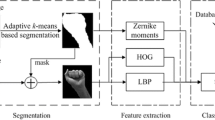Abstract
In this paper, a new, glove-free method for recognition of fingerspelled acronyms using hierarchical temporal memory has been proposed. The task is challenging because many signs look similar from the camera viewpoint. Moreover handshapes are distorted strongly as a result of coarticulation and motion blur, especially in the fluent fingerspelling. In the described work, the problem has been tackled by applying the new, bio-inspired recognition engine, based on structural and functional properties of mammalian neocortex, robust to local changes shape descriptors, and a training scheme allowing for capture possible handshape deformations in a manner that is lexicon independent.
Access this chapter
Tax calculation will be finalised at checkout
Purchases are for personal use only
Preview
Unable to display preview. Download preview PDF.
Similar content being viewed by others
References
Oz, C., Leu, M.C.: Recognition of Finger Spelling of American Sign Language with Artificial Neural Network Using Position/Orientation Sensors and Data Glove. In: Wang, J., Liao, X.-F., Yi, Z. (eds.) ISNN 2005. LNCS, vol. 3497, pp. 157–164. Springer, Heidelberg (2005)
Tabata, Y., Kuroda, T.: Finger Spelling Recognition using Distinctive Features of Hand Shape. In: Proceedings of International Conference on Disability, Virtual Reality and Associated Technologies, pp. 287–292 (2008)
Shimada, M., Iwasaki, S., Asakura, T.: Finger Spelling Recognition using Neural Network with Pattern Recognition Model. In: SICE Annual Conference, pp. 2458–2463 (2003)
Altun, O., Albayrak, S., Ekinci, A., Bükün, B.: Turkish Fingerspelling Recognition System Using Axis of Least Inertia Based Fast Alignment. In: Sattar, A., Kang, B.-h. (eds.) AI 2006. LNCS (LNAI), vol. 4304, pp. 473–481. Springer, Heidelberg (2006)
Suraj, M.G., Guru, D.S.: Appearance Based Recognition Methodology for Recognising Fingerspelling Alphabets. In: International Joint Conference on Artificial Intelligence, pp. 605–610 (2007)
Liwicki, S., Everingham, M.: Automatic recognition of fingerspelled words in British sign language. In: Proceedings of the 2nd IEEE Workshop on CVPR for Human Communicative Behavior Analysis (CVPR4HB 2009), in conjunction with CVPR 2009, pp. 50–57 (2009)
Ricco, S., Tomasi, C.: Fingerspelling Recognition through Classification of Letter-to-Letter Transitions. In: Zha, H., Taniguchi, R.-i., Maybank, S. (eds.) ACCV 2009, Part III. LNCS, vol. 5996, pp. 214–225. Springer, Heidelberg (2010)
George, D., Hawkins, J.: Towards a Mathematical Theory of Cortical Microcircuits. PLoS Computational Biology, e1000532 (2009)
Kapuscinski, T.: Using Hierarchical Temporal Memory for Vision-Based Hand Shape Recognition under Large Variations in Hand”s Rotation. In: Rutkowski, L., Scherer, R., Tadeusiewicz, R., Zadeh, L.A., Zurada, J.M. (eds.) ICAISC 2010. LNCS (LNAI), vol. 6114, pp. 272–279. Springer, Heidelberg (2010)
Kapuściński, T.: Hand Shape Recognition in Real Images Using Hierarchical Temporal Memory Trained on Synthetic Data. In: Choraś, R.S. (ed.) Image Processing and Communications Challenges 2. AISC, vol. 84, pp. 193–200. Springer, Heidelberg (2010)
Author information
Authors and Affiliations
Editor information
Editors and Affiliations
Rights and permissions
Copyright information
© 2012 Springer-Verlag Berlin Heidelberg
About this paper
Cite this paper
Kapuscinski, T. (2012). Vision-Based Recognition of Fingerspelled Acronyms Using Hierarchical Temporal Memory. In: Rutkowski, L., Korytkowski, M., Scherer, R., Tadeusiewicz, R., Zadeh, L.A., Zurada, J.M. (eds) Artificial Intelligence and Soft Computing. ICAISC 2012. Lecture Notes in Computer Science(), vol 7267. Springer, Berlin, Heidelberg. https://doi.org/10.1007/978-3-642-29347-4_61
Download citation
DOI: https://doi.org/10.1007/978-3-642-29347-4_61
Publisher Name: Springer, Berlin, Heidelberg
Print ISBN: 978-3-642-29346-7
Online ISBN: 978-3-642-29347-4
eBook Packages: Computer ScienceComputer Science (R0)




